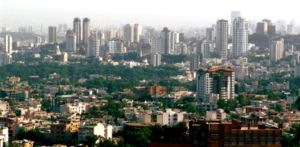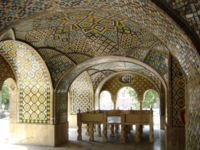
Home
TEHRAN
Tehran (IPA: Tehran), population (as of 2006) 7,354,000 (metropolitan: 12,651,000), and a land area of 658 square kilometres (254 sq mi), is the capital city of Iran and the center of Tehran Province.
More than half of Iran's industry is based in Tehran. Industries include the manufacturing of automobiles, electronics and electrical equipment, military weaponry, textiles, sugar, cement, and chemical products. It is also a leading center for the sale of carpets and furniture. There is an oil refinery nearby.
Tehran is a sprawling city at the foot of the Alborz mountain range with an immense network of highways unparalleled in western Asia. It is also the hub of the country's railway network. The city has numerous large museums, art centers, palace complexes and cultural centers.
In the 20th century, Tehran faced a large migration of people from all around Iran. Today, being predominantly Persian, Tehran population also includes ethnic and religious minorities such as Azeris, Armenian, Assyrians, Kurds, Jews, Bahá'ís and Zoroastrians. The city is filled with historic mosques, churches, synagogues and Zoroastrian fire temples.


Toopkhaneh Square, Tehran, the early to mid-1900s.
Azadi Square is currently the symbol of Tehran.
Khalvat Karimkhani.Excavations place the existence of settlements in Tehran as far back as 6000 BC. Tehran was well known as a village in the 9th century, but was less well-known than the city of Rhages which was flourishing nearby in the pre-Mongol era. In the 13th century, following the destruction of Ray by Mongols, many of its inhabitants fled to Tehran. In some sources of the Mongol era, the city is mentioned as "Rhages's Tehran" . The city is later mentioned in Hamdollah Mostowfi's Nuz'hat al-Qulub (written in 1340) as a famous village.
Don Ruy Gonzáles de Clavijo, a Castilian ambassador, was probably the first European to visit Tehran, stopping in July 1404, while on a journey to Samarkand (now in Uzbekistan) and the Mongol capital at the time. At this time, the city of Tehran was unwalled.
Tehran became a residence of the Safavid rulers in the 17th century. Tahmasp I built a bazaar and a wall around the city, but it somewhat fell out of favor after Abbas I turned sick when he was passing the city to go to a war with the Uzbeks.
In the early of 18th century, Karim Khan Zand ordered a palace, a harem, and a government office to be built in Tehran, possibly to declare the city his capital, but later moved his government to Shiraz. Tehran finally became the capital of Persia in 1795, when the Qajar king Agha Mohammad Khan was crowned in the city. It remains the capital to this day.
During World War II, British and Soviet troops entered the city. Tehran was the site of the Tehran Conference in 1943, attended by U.S. President Franklin D. Roosevelt, British Prime Minister Winston Churchill, and Soviet Premier Joseph Stalin.
Following the war, the city's older landmarks suffered under the rule of Mohammad Reza Shah. The Shah believed that ancient buildings such as large parts of the Golestan Palace, Takieh-ye Dowlat, the Toopkhooneh Square (pictured to the right), the magnificent city 
fortifications and the old citadel among others should not be part of a modern city.
They were systematically destroyed and modern 1950s and 1960s buildings were
built in their place. Tehran bazar was divided in half and many historic buildings were destroyed in order to build wide straight avenues in the capital. Many excellent examples of Persian Gardens also became targets to new construction projects.
The decision to carry these out is presently largely seen as a foolish mistake that hurt the visual fabric and the cultural identity of the city beyond repair.
Apartment blocks are introduced in this period. Tehran loses her famous historic charm for good.

On September 8, 1978, demonstrations against the Shah led to riots. The army reportedly opened fire on the demonstrating mob. Martial law was installed in the wake
of the ensuing revolution, from 1978–79.
During the 1980–88 Iran-Iraq War, Tehran was
the scene of repeated Scud missile attacks and air strikes against random residential and industrial targets within the city, resulting in thousands of civilian casualties. Material damage was repaired soon after each strike.
Tehran attracts war refugees in millions.
After the war, cheap soviet-style apartments multiplied throughout the city without any plan. At present, Tehran has no longer any old quarter. Ugly modern high-rise buildings dominate the city's skyline and new modern apartments have and are replacing a few remaining old houses at light speed. Tehran-style home architecture has almost vanished completely. This is often referred to as "Tehran Disaster".
 The Azadi Tower is the first landmark visitors come across when arriving from the Mehrabad International Airport. The tower has become an icon for Tehran and a national symbol of Iran.
Tehran suffers from extremely serious traffic congestion and pollution problems. Respiratory ailments such as asthma are very common. Tehran has become so congested over the past decade that the government has considered moving the nation's capital to another city to alleviate these problems and help de-centralize the economy and population. But because Iran's economy and politics are so centralized, millions have little choice but to live and work in Tehran.
The huge Tehran International Fair organizes many expositions. Its book expositions are especially popular. Tehran is also the seat of Iran's Parliament (the Majlis). And Tehran is also home to the world's fourth tallest free standing structure, the Milad Tower.
The Azadi Tower is the first landmark visitors come across when arriving from the Mehrabad International Airport. The tower has become an icon for Tehran and a national symbol of Iran.
Tehran suffers from extremely serious traffic congestion and pollution problems. Respiratory ailments such as asthma are very common. Tehran has become so congested over the past decade that the government has considered moving the nation's capital to another city to alleviate these problems and help de-centralize the economy and population. But because Iran's economy and politics are so centralized, millions have little choice but to live and work in Tehran.
The huge Tehran International Fair organizes many expositions. Its book expositions are especially popular. Tehran is also the seat of Iran's Parliament (the Majlis). And Tehran is also home to the world's fourth tallest free standing structure, the Milad Tower. The Milad Complex and the Milad TowerThe Tehran International Trade and Conventions Center, also called The Milad Complex, is one of the largest structures in Iranian architecture. It is scheduled to be finished in late 2007. The complex contains the world's 4th highest tower which has several restaurants, a five star hotel, a convention center, a world trade center, and an IT park (to be completed by March 2007). The complex seeks to respond to the needs of business in the globalized world of the 21st century by offering facilities combining trade, information, communication, convention and accommodation all in one place. The Milad Tower is predicted to replace the long-time symbol of Tehran, the Azadi Tower.
The Milad Complex and the Milad TowerThe Tehran International Trade and Conventions Center, also called The Milad Complex, is one of the largest structures in Iranian architecture. It is scheduled to be finished in late 2007. The complex contains the world's 4th highest tower which has several restaurants, a five star hotel, a convention center, a world trade center, and an IT park (to be completed by March 2007). The complex seeks to respond to the needs of business in the globalized world of the 21st century by offering facilities combining trade, information, communication, convention and accommodation all in one place. The Milad Tower is predicted to replace the long-time symbol of Tehran, the Azadi Tower. electronics and electrical equipment, weaponry, textiles, sugar, cement, and chemical products. It is also a leading center for the sale of carpets and furniture. There is an oil refinery nearby. The city has two airports, including Mehrabad International Airport, and Imam Khomeini International Airport. Tehran relies heavily on private cars, buses, motorcycles, and taxis, and is one of the most car-dependent cities in the world. The Tehran Stock Exchange, which is a full member of the Federation Internationale des Bourses de Valeurs (FIBV) and a founding member of the Federation of Euro-Asian Stock Exchanges, was one of the world's best performing stock exchanges in recent years.
electronics and electrical equipment, weaponry, textiles, sugar, cement, and chemical products. It is also a leading center for the sale of carpets and furniture. There is an oil refinery nearby. The city has two airports, including Mehrabad International Airport, and Imam Khomeini International Airport. Tehran relies heavily on private cars, buses, motorcycles, and taxis, and is one of the most car-dependent cities in the world. The Tehran Stock Exchange, which is a full member of the Federation Internationale des Bourses de Valeurs (FIBV) and a founding member of the Federation of Euro-Asian Stock Exchanges, was one of the world's best performing stock exchanges in recent years.